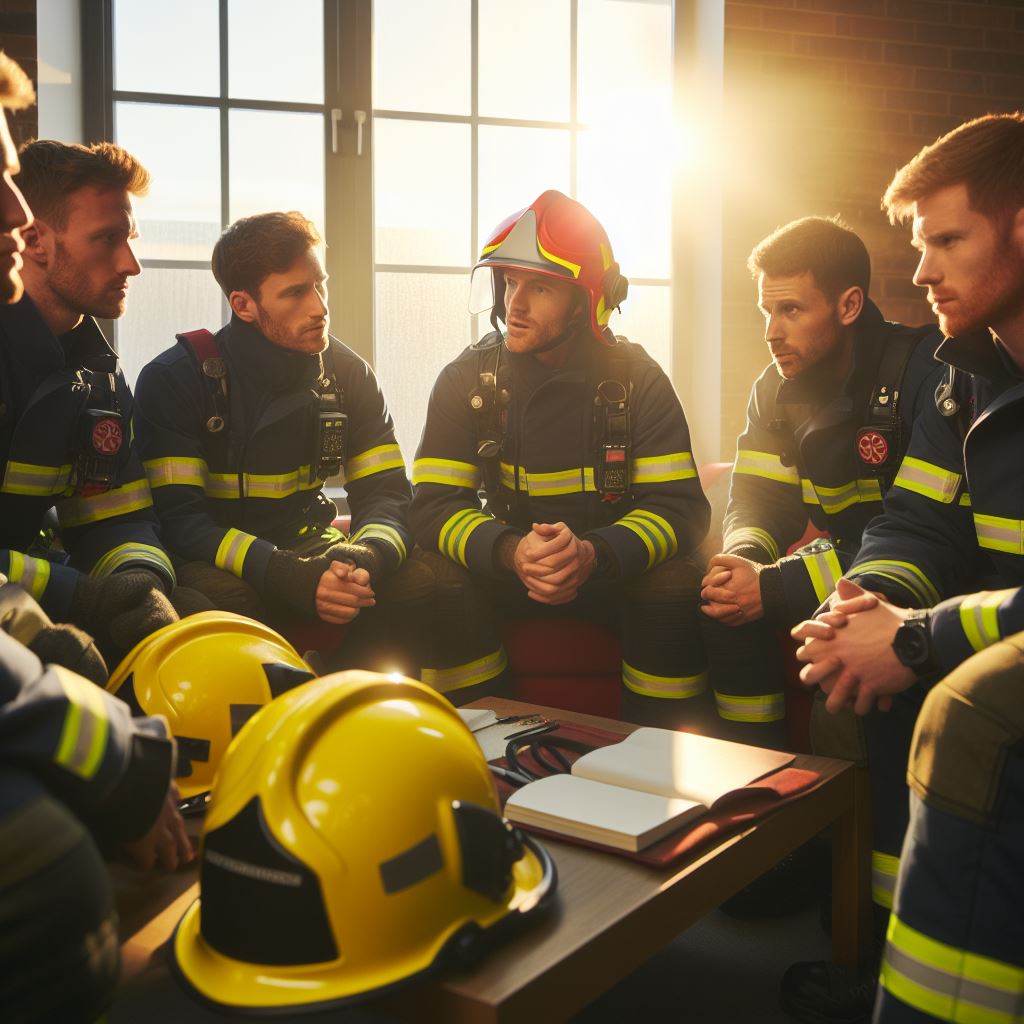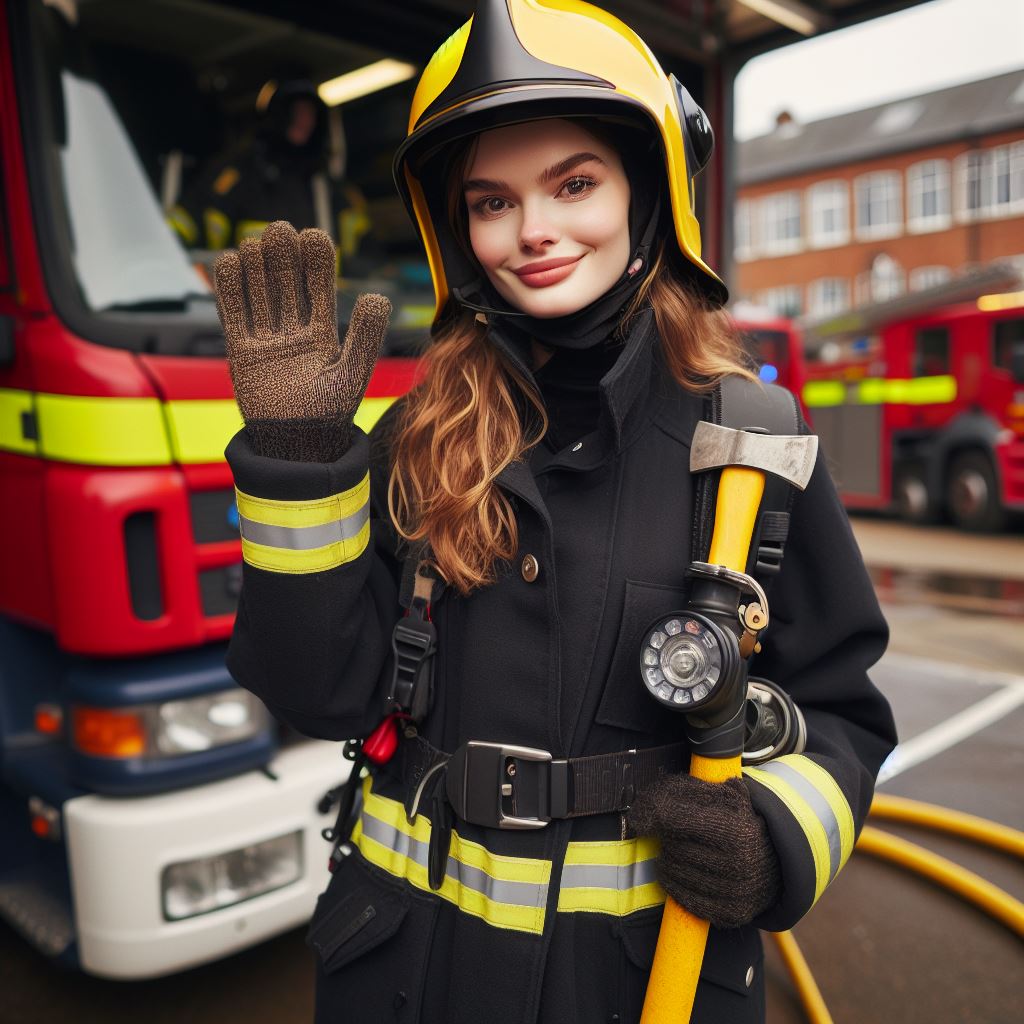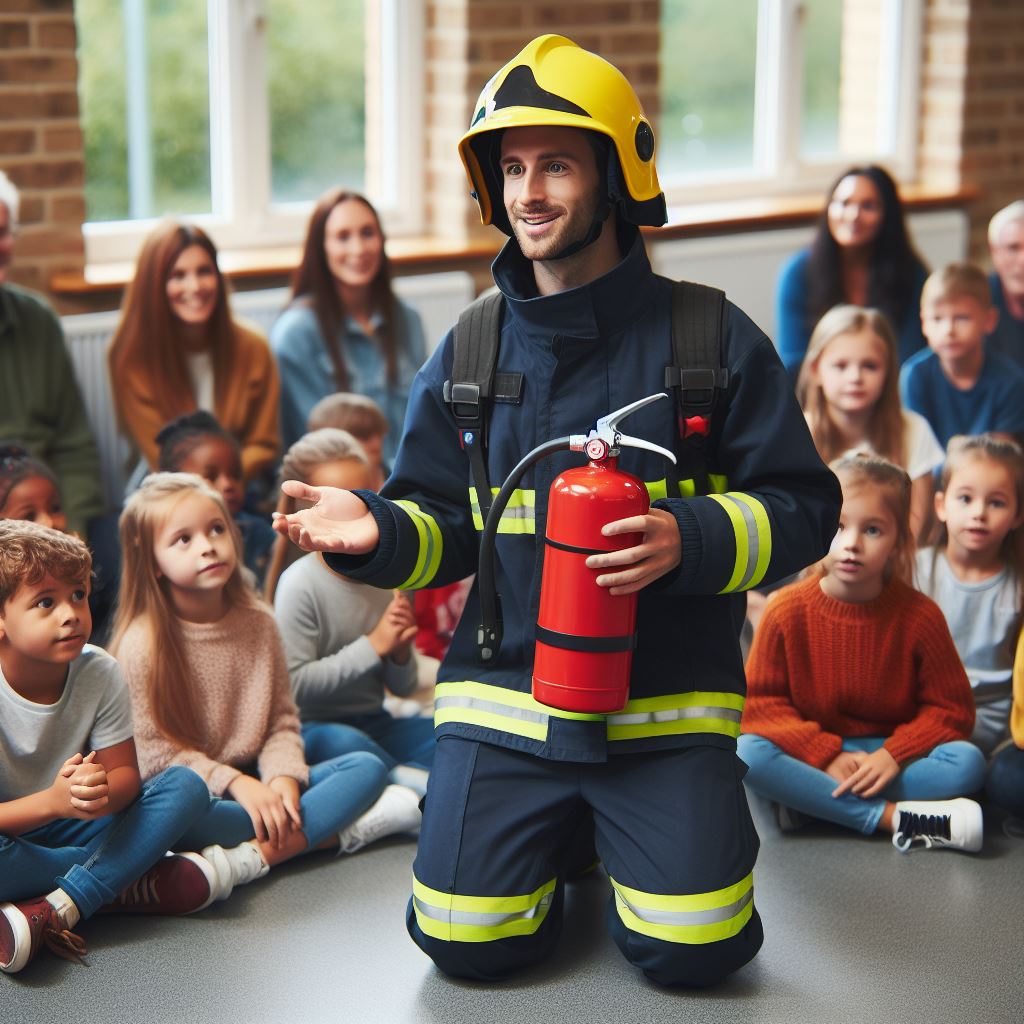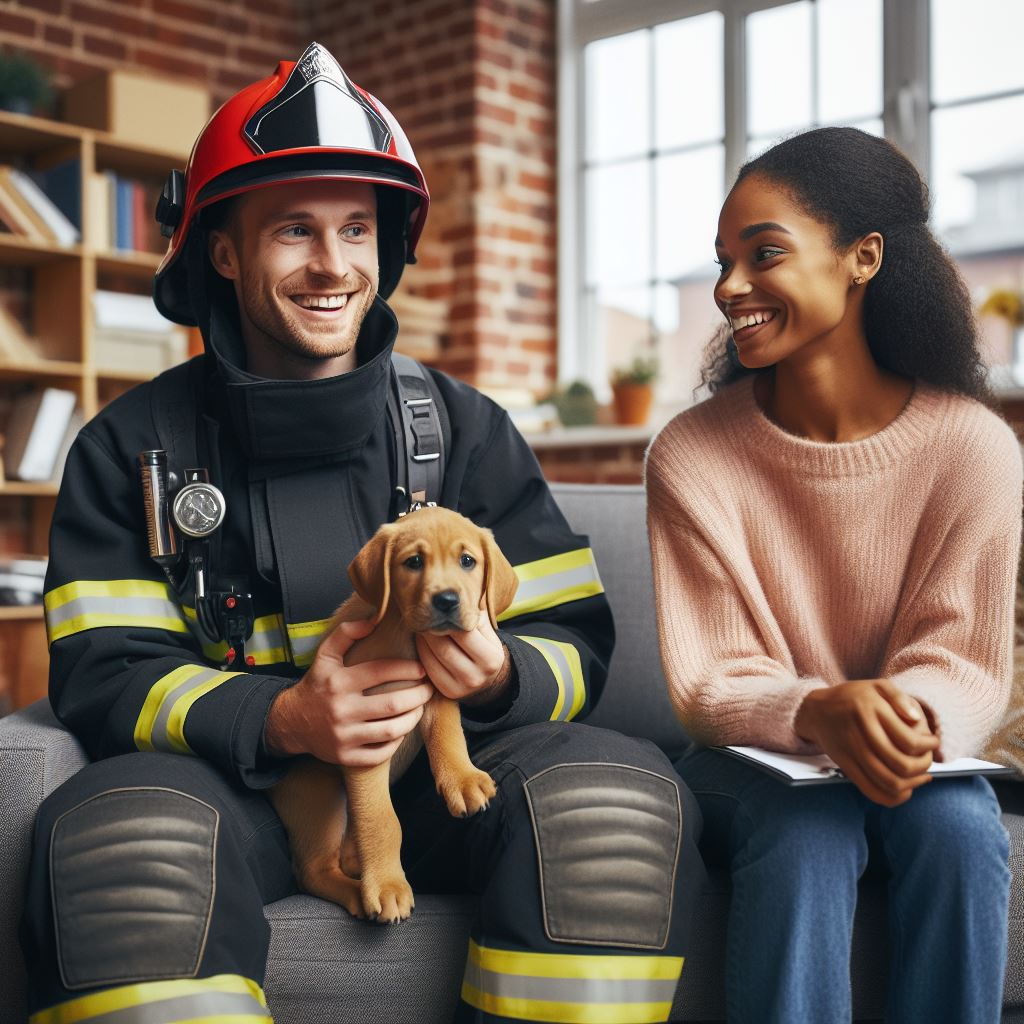Introduction
Firefighter fitness plays a crucial role in the UK due to the physically demanding nature of firefighting duties.
This blog post aims to provide valuable tips on how firefighters can stay fit for duty.
Maintaining optimal fitness levels is essential for firefighters to efficiently perform their duties.
They are frequently required to carry heavy equipment, navigate through hazardous environments, and rescue individuals in need.
As such, being physically fit is vital for their success in saving lives and protecting property.
In this blog post, we will discuss different strategies that firefighters can adopt to ensure they remain in prime physical condition.
These tips will cover various aspects of fitness, including cardiovascular health, strength training, flexibility, and overall well-being.
Cardiovascular exercises, such as running or cycling, are crucial for developing endurance and improving heart health.
Engaging in regular cardio workouts helps firefighters build the stamina required to tackle physically demanding situations effectively.
Strength training exercises, such as weightlifting or resistance training, are vital for building muscular strength and enhancing overall physical performance.
Improving core strength is especially important as it aids in stability and reduces the risk of injury while carrying out firefighting duties.
Flexibility exercises, like yoga or stretching routines, are essential for maintaining a full range of motion.
Being flexible allows firefighters to perform tasks more efficiently, reducing the risk of strains and sprains.
Additionally, this blog post will address the significance of maintaining a balanced diet, staying hydrated, and getting enough rest and recovery time for optimal performance.
In short, firefighter fitness is of utmost importance in the UK.
Personalized UK Career Consulting
Receive tailored career guidance designed just for you. Get actionable steps and expert support to boost your career in 1-3 days. Take control of your career now.
Get StartedBy following the provided tips and adopting a well-rounded approach to fitness, firefighters can ensure they are physically prepared to handle the challenges that come their way.
The Importance of Fitness for Firefighters
Physical fitness plays a crucial role in the lives of firefighters in the UK.
It is not just a job requirement, but a necessity that can determine their ability to perform their duties effectively and safely.
Being fit is not just about looking good; it goes hand in hand with skill and competence in firefighting.
A. Importance of physical fitness for firefighters in the UK
One of the primary reasons why physical fitness is of utmost importance for firefighters is because it directly enhances their job performance.
Firefighters are often required to carry heavy equipment, climb ladders, and rescue individuals from dangerous situations.
These tasks demand strength, endurance, and agility, all of which can be greatly improved through regular physical fitness training.
Furthermore, being physically fit reduces the risk of injury for firefighters.
The nature of their work exposes them to various hazards, such as falling debris, collapsing structures, and intense heat.
With a strong and well-conditioned body, firefighters are more likely to withstand such physical demands and decrease the likelihood of sustaining injuries.
Physical fitness not only helps firefighters in their day-to-day operations but also improves their overall health.
Engaging in regular exercise and maintaining a healthy lifestyle can reduce the risk of cardiovascular diseases, obesity, and other chronic conditions.
This not only benefits firefighters individually but also ensures that they can continue performing their duties efficiently for years to come.
B. Challenges firefighters face that require physical strength and stamina
- Specific challenges demand firefighters’ physical strength and stamina, such as carrying heavy hoses, breaking doors, and rescuing individuals.
- Additionally, the unpredictable nature of emergencies demands quick reflexes and endurance to sustain long hours of work.
- Firefighters need to engage in a comprehensive fitness program that includes aerobic exercise, strength training, and flexibility exercises.
- Aerobic activities like running enhance cardiovascular fitness, helping firefighters endure physically demanding situations for extended periods.
- Strength training, including weightlifting, improves muscular strength and power, allowing firefighters to perform tasks that require heavy lifting or force.
- Flexibility exercises, such as stretching or yoga, enhance the range of motion and reduce the risk of muscle strain or joint injuries.
- Furthermore, maintaining a healthy diet and ensuring adequate rest and recovery are equally important components of a firefighter’s fitness regimen.
- Proper nutrition provides the necessary fuel for physical exertion, while sufficient rest allows the body to recover and repair itself after strenuous activities.
In essence, physical fitness is of utmost importance for firefighters in the UK.
Your Dream Job Starts with a Perfect CV
Get a tailored CV and cover letter that captures your unique strengths and stands out in your industry. Let us help you make an unforgettable first impression.
Get StartedIt enhances their job performance, reduces the risk of injury, and improves overall health.
The demanding nature of their work requires physical strength and stamina, making regular exercise and a healthy lifestyle essential for firefighters to carry out their duties effectively and safely.
Read: The History of Firefighting in the United Kingdom
Fitness Requirements for UK Firefighters
A. Aspiring Firefighters: Meeting the Fitness Requirements
- Applicants to the UK Fire Service must meet certain fitness requirements during the recruitment process.
- Physical fitness is a crucial aspect of being a firefighter, as it is a physically demanding profession.
- The fitness requirements ensure that aspiring firefighters are capable of handling the challenges they will face on duty.
- These requirements include a thorough examination of an applicant’s fitness level and overall health.
- Aspiring firefighters are expected to demonstrate a level of fitness that meets the physical demands of the job.
- They must possess sufficient strength, endurance, and cardiovascular fitness to carry out firefighting duties effectively.
B. Mandatory Fitness Tests: Their Significance
- During the recruitment process, aspiring firefighters are subjected to a series of mandatory fitness tests.
- These tests assess their physical capabilities and determine their suitability for the role.
- The first test is the ladder climb, which assesses an applicant’s ability to climb and descend a ladder.
- The second test is the casualty drag, which measures an applicant’s strength and ability to rescue and carry a person.
- The third test is the equipment carry, which evaluates an applicant’s ability to carry heavy firefighting equipment.
- The fourth test is the ladder lift, which examines an applicant’s upper body strength and their ability to lift and extend a ladder.
C. Ongoing Fitness Standards for Firefighters
- Once recruited, firefighters are required to maintain a certain level of fitness throughout their careers.
- Regular fitness assessments and training sessions are conducted to ensure firefighters remain fit for duty.
- Firefighters are expected to maintain a level of cardiovascular fitness to endure physically demanding situations.
- They must also have the strength and endurance necessary to carry out rescue operations and handle firefighting equipment.
- Furthermore, firefighters need to maintain flexibility and agility to maneuver through challenging environments.
- These ongoing fitness standards are vital to ensure the safety of both firefighters and the public they serve.
In general, fitness requirements play a critical role in the recruitment and maintenance of UK firefighters.
Aspiring firefighters must meet specific fitness standards to demonstrate their capability for the physically demanding job.
Mandatory fitness tests are conducted during the recruitment process to assess applicants’ physical capabilities.
Once recruited, firefighters must consistently meet ongoing fitness standards to remain fit for duty throughout their careers.
By maintaining their physical fitness, firefighters can effectively carry out their duties and ensure public safety.
Read: UK Firefighter Training: What Does It Take?
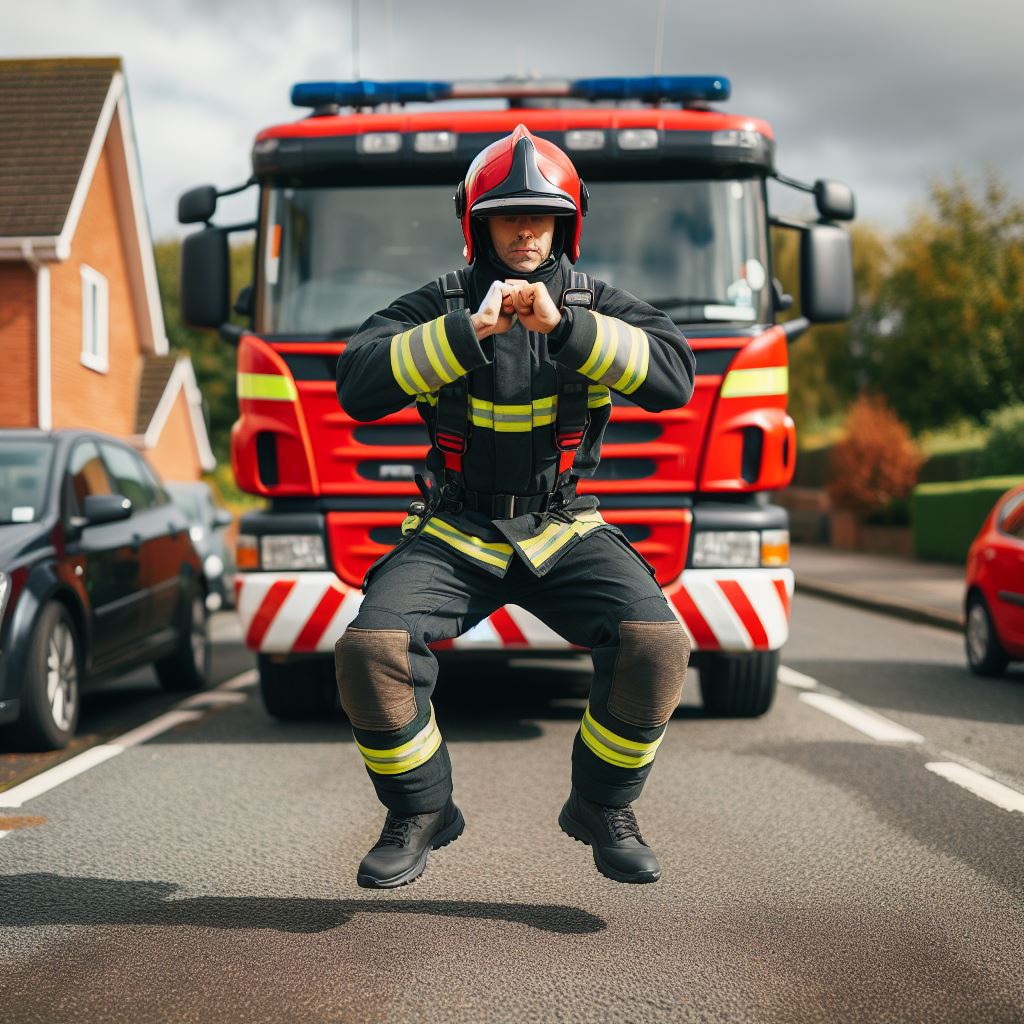
Types of Workouts Suitable for Firefighters
A. Exercise routines that are beneficial for firefighters’ specific needs
- High-intensity interval training (HIIT): These short bursts of intense exercise followed by brief rest periods help improve overall fitness and cardiovascular endurance.
- Running and jogging: Regular cardiovascular training is crucial for firefighters to enhance their endurance levels and maintain a healthy heart.
- Circuit training: This type of workout combines strength exercises with cardiovascular activities, helping firefighters develop both strength and endurance.
- Functional training: This focuses on movements that mimic real-life activities encountered during firefighting, improving muscle recruitment and overall performance.
- Weightlifting: Strength training with weights or resistance bands builds essential muscular strength and power for firefighters handling heavy equipment and rescuing victims.
- Bodyweight exercises: These include push-ups, pull-ups, and squats, which can be performed anywhere and help build functional strength and improve overall fitness.
- Yoga and Pilates: These exercises enhance flexibility, balance, core strength, and body awareness, helping firefighters maneuver through tight spaces and reduce injury risks.
- CrossFit: This high-intensity workout combines elements of cardio, weightlifting, and bodyweight exercises to enhance all aspects of fitness relevant to firefighting.
- Aerobic exercise: Activities like swimming, cycling, and rowing improve cardiovascular health and stamina, necessary for handling physically demanding firefighting tasks.
- Team sports: Engaging in team sports such as soccer or basketball helps firefighters develop teamwork skills, agility, and coordination.
B. The importance of cardiovascular training to improve endurance
Cardiovascular training is of utmost importance for firefighters as it improves their endurance and enables them to perform their duties for extended periods.
Regular cardio workouts, such as running or cycling, strengthen the heart and lungs, enhancing overall fitness.
C. Benefits of strength training for firefighters, focusing on functional movements
- Strength training is equally vital for firefighters.
- It helps build muscular strength and power, enabling them to carry heavy equipment, break through barriers, and rescue individuals in emergencies.
- Functional movements, like lifting and carrying objects, should be incorporated into strength training routines for optimal results.
D. Importance of flexibility training and its role in injury prevention
- Flexibility training plays a crucial role in injury prevention for firefighters.
- Stretching exercises help improve joint range of motion, making movements more efficient and reducing the risk of strains and sprains.
- Yoga and Pilates are excellent choices for enhancing flexibility and core strength.
Overall, a well-rounded workout routine is essential for firefighters to stay fit and perform their duties effectively.
Combining cardiovascular training, strength exercises, and flexibility workouts helps improve endurance, functional movements, and injury prevention.
By adopting a holistic approach to their fitness regimen, firefighters can ensure they are ready to face any challenge that comes their way.
Optimize Your LinkedIn for Success
Boost your LinkedIn profile with a professional bio, keyword-rich headline, and strategic recommendations that attract recruiters. Stand out from the crowd and get noticed.
Optimize NowRead: Firefighting Gear: What UK Firefighters Wear
Nutrition and Hydration Guidelines
Proper nutrition and hydration are vital for firefighters, ensuring peak performance in physically demanding roles.
A. Importance of proper nutrition and hydration for firefighters
- Fueling the Body: Firefighters need a well-balanced diet to provide energy for their demanding tasks.
- Muscle Maintenance: Protein-rich foods aid in muscle repair and maintenance after strenuous activities.
B. Dietary considerations for individuals with physically demanding jobs
- Significance of Hydration: Adequate water intake is crucial to prevent dehydration during intense firefighting activities.
- Electrolyte Balance: Replenishing electrolytes lost through sweating is essential for optimal performance and health.
- Increased Caloric Needs: Firefighters require higher caloric intake due to their physically demanding job requirements.
- Nutrient-rich foods: Emphasize the consumption of nutrient-dense foods to meet increased energy demands.
C. Tips on maintaining a balanced diet and strategies for staying hydrated
- Lean Proteins: Incorporate lean proteins like chicken, fish, and plant-based sources for muscle support.
- Complex Carbohydrates: Whole grains and vegetables provide sustained energy for long-duration tasks.
- Healthy Fats: Include sources like avocados and nuts to support overall health.
- Pre-Task Hydration: Firefighters should start hydrating before shifts to ensure optimal fluid levels.
- Regular Water Breaks: Schedule breaks to encourage firefighters to stay hydrated throughout their shifts.
To sum it up, proper nutrition and hydration are essential for firefighters to stay fit and perform their duties efficiently.
By following these guidelines and incorporating healthy habits, firefighters can optimize their physical performance and overall well-being.
Remember, fueling your body with the right nutrients and staying adequately hydrated is key to maintaining peak performance in the challenging field of firefighting.
Read: A Day in the Life of a UK Firefighter
Additional Considerations for Firefighter Fitness
A. The Psychological Aspect of Firefighter Fitness
- Firefighter fitness goes beyond physical strength and endurance; mental well-being is equally important.
- To deal with high-stress situations, firefighters must have strong coping mechanisms and resilience.
- Mental health includes managing emotions, maintaining a positive mindset, and seeking support when needed.
- A healthy mental state improves decision-making abilities, reaction time, and overall job performance.
- Firefighters should undergo regular psychological evaluations to identify and address any potential mental health issues.
B. The Role of Rest and Recovery
- Rest and recovery play a crucial role in maintaining optimal fitness levels for firefighters.
- Proper sleep is essential for muscle repair, cognitive function, and overall well-being.
- Insufficient rest can lead to fatigue, decreased concentration, and a higher risk of injuries.
- Including rest days in training schedules allows the body to recover and prevent overtraining.
- Active recovery activities, such as yoga or light stretching, can promote blood flow and muscle repair.
C. The Significance of Regular Health Check-ups and Screenings
- Regular health check-ups for firefighters are vital to identify any potential health risks or issues.
- Annual medical examinations can detect underlying conditions that may affect job performance.
- Special screenings, such as cardiac tests, help assess firefighters’ cardiovascular health.
- Identifying and addressing health problems early can prevent them from becoming severe or life-threatening.
- Fire departments should provide resources and support to ensure firefighters prioritize their health.
- By addressing the psychological aspect of firefighter fitness, we acknowledge the importance of mental well-being in addition to physical strength.
- Firefighters face highly demanding and often traumatic situations that require resilience and emotional stability.
- Regular psychological evaluations should be conducted to assess and support mental health.
- Furthermore, rest and recovery should be prioritized as part of maintaining optimal fitness.
- Firefighters must recognize that adequate rest allows their bodies to repair and prevent injuries.
- Incorporating rest days into training schedules and engaging in active recovery activities can enhance overall fitness levels and reduce the risk of burnout.
- Regular health check-ups and screenings are critical for firefighters to monitor their physical health.
- Annual medical examinations can detect any underlying conditions that may affect their ability to perform their duties safely.
- Specific screenings, such as cardiac tests, can assess cardiovascular fitness, which is crucial for firefighting roles.
- Timely identification and treatment of health issues can prevent them from becoming severe and compromising firefighters’ well-being.
In closing, firefighter fitness extends beyond physical prowess and encompasses psychological well-being, rest and recovery, and regular health check-ups.
To ensure firefighters are fit for duty, these additional considerations must be prioritized.
By addressing all aspects of firefighter fitness, firefighters can maintain their overall health and perform their duties effectively and safely.
Find Out More: Understanding UK Political Party Whips’ Roles
Discover More: UK Politicians’ Salaries: Facts and Figures
Discover More: Challenges Faced by UK Local Gov Officers
Conclusion
Maintaining fitness is crucial for firefighters in the UK to perform their duties effectively and safely.
Being physically fit helps them withstand the demands of their job, such as carrying heavy equipment and rescuing people in dangerous situations.
Ignoring fitness can lead to serious consequences, both for the firefighters themselves and the individuals they are trying to save.
Firefighters should prioritize their fitness and make it a daily commitment.
Regular exercise, such as cardiovascular training and strength training, should be incorporated into their routines.
Additionally, a balanced and healthy diet is essential for maintaining optimal physical health.
Throughout this blog post, we have highlighted the importance of firefighter fitness and discussed various aspects of staying fit for duty.
We emphasized the significance of cardiovascular endurance, muscular strength, and flexibility in enabling firefighters to perform their tasks efficiently.
By maintaining a high level of fitness, firefighters can also reduce the risk of injuries and improve their overall wellbeing.
We encourage all firefighters to take their fitness seriously and prioritize it in their lives.
The physical demands of their profession require them to be in top shape, and neglecting fitness can have severe consequences.
By dedicating themselves to regular exercise and maintaining a healthy lifestyle, firefighters can ensure they are prepared to face any challenges that come their way.
We urge readers to take action today and start making positive changes towards improving their fitness for duty. Your health and the safety of others depend on it.
[E-Book for Sale]
500 Cutting-Edge Tech Startup Ideas for 2024 & 2025: Innovate, Create, Dominate
$19.99 • 500 Tech Startup Ideas • 62 pages
You will get inspired with 500 innovative tech startup ideas for 2024 and 2025, complete with concise descriptions to help you kickstart your entrepreneurial journey in AI, Blockchain, IoT, Fintech, and AR/VR.

